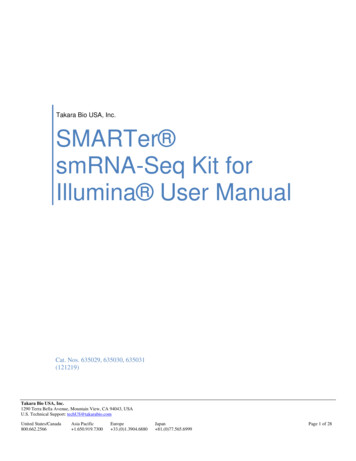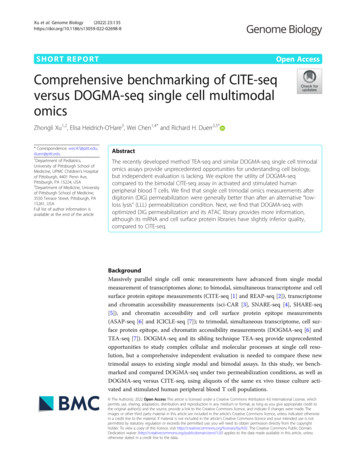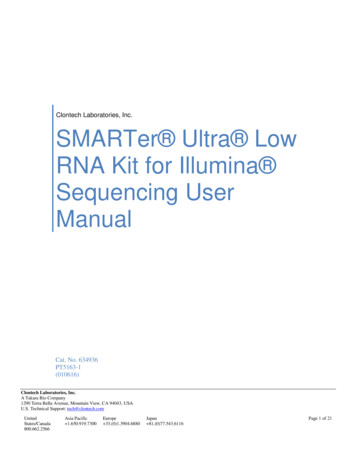
Transcription
Takara Bio USA, Inc.SMARTer smRNA-Seq Kit forIllumina User ManualCat. Nos. 635029, 635030, 635031(121219)Takara Bio USA, Inc.1290 Terra Bella Avenue, Mountain View, CA 94043, USAU.S. Technical Support: techUS@takarabio.comUnited States/Canada800.662.2566Asia Pacific 1.650.919.7300Europe 33.(0)1.3904.6880Japan 81.(0)77.565.6999Page 1 of 28
SMARTer smRNA-Seq Kit for Illumina User ManualTable of ContentsI.Introduction . 3II.List of Components . 6III.Additional Materials Required . 8IV.General Considerations . 9A.Recommendations for Preventing Contamination . 9B.General Requirements . 9C.Sample Recommendations . 10V.Protocols . 12A.Protocol: Polyadenylation . 12B.Protocol: cDNA Synthesis . 13C.Protocol: PCR and Cleanup . 14D.Protocol: Library Validation . 16E.Protocol: Size Selection Using Agencourt AMPure XP Beads . 18F.Protocol: Size Selection Using the BluePippin System . 20Appendix A: Sequencing Guidelines . 23A.General Recommendations . 23B.Expected Performance During Sequencing . 24C.Analysis of Sequencing Reads . 26VI.References . 27Table of FiguresFigure 1. Schematic of technology used by the SMARTer smRNA-Seq Kit for Illumina . 4Figure 2. Library preparation workflow for the SMARTer smRNA-Seq Kit for Illumina. 5Figure 3. Example electropherogram results for smRNA-seq libraries . 17Figure 4. Example electropherogram results for smRNA-seq libraries before and after bead-based size selection . 20Figure 5. Example electropherogram results for smRNA-seq libraries after size selection with the BluePippin system . 22Figure 6. Example electropherogram results for smRNA-seq libraries profiled on a fragment analyzer . 22Figure 7. Percentage base calling from a typical MiSeq run performed on libraries generated from the miRXploreUniversal Reference . 25Figure 8. Percentage base calling from a typical MiSeq run following gel-free (AMPure beads) size selection . 25Figure 9. Percentage base calling from a typical MiSeq run following BluePippin size selection . 26Figure 10. Example of a 50-bp read from a library generated with the SMARTer smRNA-seq kit . 26Figure 11. Example of possible reads obtained before and after trimming . 27Table of TablesTable I. Cycling guidelines based on type and amount of starting material. . 15Table II. Recommended SMARTer smRNA-seq library loading concentrations. 23Table III. Recommended PhiX spike-in amounts . 24(121219)takarabio.comTakara Bio USA, Inc.Page 2 of 28
SMARTer smRNA-Seq Kit for Illumina User ManualI.IntroductionsmRNA-seq using SMART TechnologyThe SMARTer smRNA-Seq Kit for Illumina (Cat. Nos. 635029, 635030, 635031) is designed to generate highquality smRNA-seq libraries for sequencing on Illumina platforms. This kit was developed to work directly withtotal RNA or enriched small RNA inputs ranging from 1 ng–2 µg. By incorporating features including TakaraBio’s proprietary SMART (Switching Mechanism at the 5’ end of RNA Template) technology and locked nucleicacids (LNAs), this kit allows users to analyze a wide range of smRNA species and generate sequencing librariesof considerable complexity from as little as 1 ng of input material. Illumina adapter and index sequences areincorporated in a ligation-free manner during library amplification (Figure 1), ensuring that diverse smRNAspecies are represented with minimal bias.This kit: Enables users to analyze diverse RNA species, including miRNA, piRNA, snoRNA, and snRNA, frominputs of total RNA or enriched smRNAGenerates sequencing libraries using a method that includes polyadenylation, cDNA synthesis, and PCRamplification steps, with optional protocols for library purification and size selectionAvoids biases associated with adapter ligation through 3’ polyadenylation of input RNA and templateswitching during cDNA synthesisIncorporates Illumina TruSeq HT (currently known as TruSeq CD) index sequences during libraryamplification, allowing for multiplexing of sequencing libraries on a single flow cell laneIncludes the Macherey-Nagel NucleoSpin Gel and PCR Clean-Up kit for easy library purificationfollowing PCR amplificationEmploys a quick, single-tube workflow (Figure 2) which can be performed within 3 hours (not includingvalidation and post-PCR size-selection steps)Following PCR amplification, purification, and validation, sequencing libraries may require size selectiondepending on the input material and experimental objectives. Size selection can be performed using either SPRI(Solid Phase Reversible Immobilization) beads or the BluePippin system, and is particularly beneficial whenprocessing libraries derived from total RNA inputs. In contrast, libraries generated from PAGE-purified smRNAfractions may not require post-PCR size selection. Whereas a gel-free, bead-based double size selection broadlyretains library molecules containing inserts in the 15 bp–150 bp size range, the BluePippin system allows formore stringent selection of library molecules containing inserts of specific sizes.(121219)takarabio.comTakara Bio USA, Inc.Page 3 of 28
SMARTer smRNA-Seq Kit for Illumina User ManualFigure 1. Schematic of technology used by the SMARTer smRNA-Seq Kit for Illumina. SMART technology is used in a ligation-free workflowto generate sequencing libraries for Illumina platforms. Input RNA is first polyadenylated in order to provide a priming sequence for an oligo(dT)primer. cDNA synthesis is primed by the 3’ smRNA dT Primer, which incorporates an adapter sequence (green) at the 5’ end of each first-strandcDNA molecule. When the MMLV-derived PrimeScript Reverse Transcriptase (RT) reaches the 5’ end of each RNA template, it adds nontemplated nucleotides which are bound by the SMART smRNA Oligo—enhanced with locked nucleic acid (LNA) technology for greater sensitivity.In the template-switching step, PrimeScript RT uses the SMART smRNA Oligo as a template for the addition of a second adapter sequence (purple)to the 3’end of each first-strand cDNA molecule. In the next step, full-length Illumina adapters (including index sequences for sample multiplexing)are added during PCR amplification. The Forward PCR Primer binds to the sequence added by the SMART smRNA Oligo, while the Reverse PCRPrimer binds to the sequence added by the 3’ smRNA dT Primer. Resulting library cDNA molecules include sequences required for clustering on anIllumina flow cell (P5 shown in light blue, P7 shown in red), Illumina TruSeq HT (currently known as TruSeq CD) index sequences (Index 2 [i5]shown in orange, Index 1 [i7] shown in yellow), and sequences bound by the Read Primer 1 or Read Primer 2 sequencing primers (shown in purpleand green, respectively). Note that adapter sequences included in the final library add 153 bp to the size of RNA-derived insert sequences.(121219)takarabio.comTakara Bio USA, Inc.Page 4 of 28
SMARTer smRNA-Seq Kit for Illumina User ManualStarting Material: RNABegin with 1 ng–2 µg of total RNA or smRNAPolyadenylation (Section V.A)Total time 10 mincDNA Synthesis (Section V.B)Total time 1 hr 20 minPCR and Cleanup (Section V.C)Total time 1 hrLibrary Validation (Section V.D)Total time 1 hr 30 minGel-Free, Bead-Based SizeSelection (Section V.E)BluePippin Size Selection(Section V.F)Total time 1 hrTotal time 1 hr 30 minPost-Size-Selection Library Validation (Section V.D)Total time 1 hr 30 minFigure 2. Library preparation workflow for the SMARTer smRNA-Seq Kit for Illumina. Size selection (highly recommended) is performedafter library production, purification, and validation using either SPRI beads (Section V.E) or the BluePippin system (Section V.F), with the lattermethod affording greater user control over final library insert sizes. Total time for each section will vary depending on the number of samples beingprocessed.(121219)takarabio.comTakara Bio USA, Inc.Page 5 of 28
SMARTer smRNA-Seq Kit for Illumina User ManualI.List of ComponentsThe SMARTer smRNA-Seq Kit for Illumina consists of the SMARTer smRNA-Seq Kit Components (not soldseparately), the Indexing Primer Set HT for Illumina (not sold separately), the NucleoSpin Gel and PCR Clean-Up kit, andSeqAmp DNA Polymerase. These components have been specifically designed to work together and are optimizedfor this particular protocol. Please do not make any substitutions. The substitution of reagents in the kit and/or amodification of the protocol may lead to unexpected results. Please make sure to spin down tubes to collect all theliquid at the bottom before first use.Cap color635029(12 rxns)635030(48 rxns)635031(96 rxns)SeqAmp DNA Polymerasea-50 µl200 µl200 µlSeqAmp PCR Buffer (2X)-1.25 ml4 x 1.25 ml4 x 1.25 mlSMARTer smRNA-Seq Kit for IlluminaSeqAmp DNA Polymerase (Store at –20 C.)SMARTer smRNA-Seq Kit for Illumina Components(Not sold separately. Storage conditions are listed below for Package 1 and Package 2.)Package 1 (Store at –70 C.)Control RNA - miR163sb (10 ng/µl)Red5 µl5 µl5 µlPink80 µl320 µl640 µlsmRNA Mix 1Blue30 µl120 µl240 µlATPBlue12 µl48 µl96 µlRNase Inhibitor (40 U/µl)White12 µl48 µl96 µlPoly(A) Polymerase (2 U/µl)Blue10 µl24 µl48 µl3’ smRNA dT PrimerPink12 µl48 µl96 µlWhite24 µl96 µl192 µl-1.25 ml2 x 1.25 ml4 x 1.25 mlOrange1.25 ml3 x 1.25 ml5 x 1.25 mlBinding Buffer NT1-40 ml40 ml200 mlWashing Buffer NT3 (Concentrate)-25 ml25 ml2 x 50 mlElution Buffer NE (10 mM Tris-Cl, pH 8.5)-13 ml13 ml30 mlNucleoSpin Gel and PCR Clean-Up Columns-5050250Collection Tubes (2 ml)-5050250csmRNA Mix 2Package 2 (Store at –20 C.)PrimeScript RT (200 U/µl)Nuclease-Free WaterTris Buffer (5 mM)NucleoSpin Gel and PCR Clean-Up (Store at room temperature)aSeqAmp DNA Polymerase is a hot-start enzyme.Control RNA - miR163s is derived from plant miR163. See “Using Control RNA - miR163” in Section IV.C for sequenceinformation.c smRNA Mix 2 contains the template-switching oligo with LNA technology.b(121219)takarabio.comTakara Bio USA, Inc.Page 6 of 28
SMARTer smRNA-Seq Kit for Illumina User ManualIndexing Primer Sets (Not sold separately. Store at –70 C.)HT for Illumina Indexing Primer Set versionHT for Illumina - 48 A12Cat. No.635029635030Size12 rxns48 rxnsForward PrimersF1b2 x 15 µl12 μMF22 x 15 µl2 x 15 µlFull names ofF32 x 15 µlprimers haveF42 x 15 µlbeen shortenedaF5F6F7F8Reverse PrimersR112 µl12 µl12 μMR212 µl12 µlFull names ofR312 µl12 µlprimers haveR412 µl12 µlbeen shortenedaR512 µl12 µlR612 µl12 µlR712 µl12 µlR812 µl12 µlR912 µl12 µlR1012 µl12 µlR1112 µl12 µlR1212 µl12 µlHT for Illumina63503196 rxns2 x 15 µl2 x 15 µl2 x 15 µl2 x 15 µl2 x 15 µl2 x 15 µl2 x 15 µl2 x 15 µl2 x 12 µl2 x 12 µl2 x 12 µl2 x 12 µl2 x 12 µl2 x 12 µl2 x 12 µl2 x 12 µl2 x 12 µl2 x 12 µl2 x 12 µl2 x 12 µlaFull names of primers have been shortened: for example, Forward PCR Primer HT Index 2 has beenshortened to F2 and Reverse PCR Primer HT Index 1 has been shortened to R1.bF1–F8 indexes correspond to Illumina TruSeq HT (currently known as TruSeq CD) indexes D501–D508;R1–R12 indexes correspond to Illumina TruSeq HT (currently known as TruSeq CD) indexes D701–D712.Indexing Primer Set HT for Illumina barcode sequences:i5 Index(Tube Ci7 Index(Tube .comTakara Bio USA, CTCGCGCAGCGATAGPage 7 of 28
SMARTer smRNA-Seq Kit for Illumina User ManualStorage Conditions II.Store Control RNA - miR163s, smRNA Mix 2, and Indexing Primer Set HT for Illumina at –70 C.Store NucleoSpin Gel and PCR Clean-Up reagents at room temperature.Store all other reagents at –20 C.Additional Materials RequiredThe following reagents and materials are required but not supplied. They have been validated to work with thisprotocol. Please do not make any substitutions because you may not obtain the expected results: Single-channel pipettes: 10 µl, 20 µl, and 200 µl, two each (one set for pre-PCR amplification steps andone set dedicated for PCR amplification)Eight-channel pipettes (recommended): 20 µl and 200 µlFilter pipette tips: 2 µl, 20 µl, and 200 µlVortex mixerHot-lid PCR thermal cyclers: two (one dedicated for pre-PCR amplification steps and one dedicated forPCR amplification).NOTE: The PCR thermal cycler intended for PCR amplification must be compatible with 100 µl of PCRreaction mix per reaction.Microcentrifuge for 1.5-ml tubesMinicentrifuge for 0.2-ml tubes or strips96–100% ethanol (molecular biology grade)96-well PCR chiller rack: IsoFreeze PCR Rack (MIDSCI, Cat. No. 5640-T4) or 96-Well AluminumBlock (Light Labs, Cat. No. A-7079)NOTE: A PCR chiller rack is essential to keep samples cold during several steps of the protocol. Be sureto decontaminate the ice bucket and the PCR chiller rack before each use.For PCR Amplification & Validation: Agilent Bioanalyzer and Agilent High Sensitivity DNA Kit (Agilent, Cat. No. 5067-4626)NOTE: Library validation can also be performed using an Advanced Analytical Fragment Analyzer withthe High Sensitivity Small Fragment Kit (Advanced Analytical, Cat. No. DNF-477)Qubit Fluorometer (Thermo Fisher Scientific); Qubit dsDNA HS Assay Kit and 500-µl Assay Tubes(Thermo Fisher Scientific; Q32851 and Q32856, respectively)Nuclease-free thin-wall PCR tubes or strips (0.2-ml PCR 8-tube strip; USA Scientific, Item No.1402-4700)Nuclease-free low-adhesion 1.5-ml tubes (USA Scientific, Item No. 1415-2600) or LoBind tubes(Eppendorf, Cat. No. 022431021)For Gel-Free Size Selection Using SPRI (Solid Phase Reversible Immobilization) Beads (Protocol V.E): (121219)Agencourt AMPure XP PCR purification kit(5-ml size: Beckman Coulter Item No. A63880; 60-ml size: Beckman Coulter Item No. A63881)NOTE: In order to decrease the chances of bead contamination and to ensure that beads are uniformlydistributed, we strongly recommend aliquoting the beads into 1.5-ml tubes upon receipt, and thenrefrigerating the aliquots. Individual aliquots can be removed for each experiment, allowing them to cometo room temperature more quickly ( 30 minutes). Mix well to disperse the beads before adding them toyour reactions. The beads are viscous, so pipette slowly.takarabio.comTakara Bio USA, Inc.Page 8 of 28
SMARTer smRNA-Seq Kit for Illumina User Manual 80% ethanol (molecular biology grade): freshly made for each experimentMagnetic separation device for small volumes (Magnetic Separator - PCR Strip; Takara Bio, Cat. No. 635011)For Size Selection Using the BluePippin System (Protocol V.F): III.BluePippin Size Selection System (Sage Science, BLU0001)BluePippin 3% Agarose Gel Cassettes—for targets between 100 and 200 bp (Sage Science, Cat. No.BDQ3010)General ConsiderationsA.Recommendations for Preventing Contamination1. Before you set up the experiment, it is advisable to have three physically separated workstations: A PCR-clean work station for all pre-PCR experiments that require clean roomconditions such as first-strand cDNA synthesis (Section V.B). A second work station located in the general laboratory where you will perform PCR(Section V.C). A third work station located in the general laboratory where you will purify (SectionV.C), quantify, and validate the library (Section V.D).IMPORTANT: We recommend three separate work areas in order to avoid contaminatingsamples with PCR products from previous reactions. Since the PCR primers recognizesequences common to all libraries, setting up new reactions in the same area where the finallibrary cleanup occurs increases the risk of contamination. The PCR-clean work stationmust be located in a room with positive air flow, as contamination may occur very easily.Once contamination occurs, it can be difficult to remove. While the use of three separatework areas is not an absolute requirement, it can greatly minimize contamination andensure the preparation of great-quality libraries every time.2. Guidelines for PCR-clean work station operation: Only move materials/supplies from the PCR-clean work station to the general lab, NOTthe other way around. Do not share any equipment/reagents between the PCR-clean workstation and the general lab work stations. Use a separate PCR thermal cycler (dedicated to first-strand cDNA synthesis) inside thePCR-clean work station for first-strand cDNA synthesis. Wear gloves and sleeve covers throughout the procedure to protect your RNA samplesfrom degradation by contaminants and nucleases. Be sure to change gloves and sleevecovers between each section of the protocol.B.General Requirements (121219)The success of your experiment depends on the purity of your input RNA and the retention ofsmRNA during RNA extraction. Prior to using this kit, please make sure that your RNA isfree of contaminants and has been extracted using a method that preserves smRNA fractions.The assay is very sensitive to variations in pipette volume, etc. Please make sure that all pipettes arecalibrated for reliable reagent delivery and that nothing adheres to the outside of the tips whendispensing liquids.takarabio.comTakara Bio USA, Inc.Page 9 of 28
SMARTer smRNA-Seq Kit for Illumina User Manual C.All lab supplies related to cDNA synthesis need to be stored in a DNA-free, closed cabinet. Ideally, reagentsfor cDNA synthesis should be stored in a freezer/refrigerator that has not previously been used to store PCRamplicons.Add enzymes to reaction mixtures last, and thoroughly incorporate them by gently pipetting the reactionmixtures up and down.Do not change the amount or concentration of any of the components in the reactions; they have beencarefully optimized for the SMARTer reagents and protocol.If you are using this protocol for the first time, we strongly recommend that you perform negative (withoutRNA) and positive (with provided Control RNA - miR163s) control reactions.Sample RecommendationsInput RNA Quality This kit is designed to generate high-quality sequencing libraries from inputs consisting of eithertotal RNA or enriched (e.g. PAGE- or column-purified) smRNA. For column purification ofsmRNA species 200 nt, Takara Bio offers the Macherey-Nagel NucleoSpin miRNA kit (Cat.No. 740971).For inputs consisting of total RNA, performance of the SMARTer smRNA-Seq Kit for Illuminais dependent on the quality of the RNA starting material. While the use of high-quality total RNA(RIN 8) is recommended, the kit may also perform well with partially degraded samples. Pleasebe aware, though, that sample degradation may result in underrepresentation of smRNAs in finalsequencing libraries. After RNA extraction, purification, and size selection (optional), werecommend evaluating total RNA quality using the Agilent RNA 6000 Pico Kit (Agilent, Cat.No. 5067-1513). Refer to the manufacturer’s instructions about how to use the Agilent RNA 6000Pico Kit.The initial polyadenylation step in the kit workflow (Section V.A) requires the presence of an OH group at RNA 3’ ends, and RNA templates obtained from methods such as ribosomeprofiling or CLIP may require dephosphorylation prior to library preparation in order to provide asuitable substrate for Poly(A) Polymerase.Input RNA Purity and Quantity Purity of input RNA: Input RNA should be free from poly(A) carrier RNA and contaminantsthat would interfere with oligo(dT)-primed cDNA synthesis, and (ideally) dissolved in water.Samples should also be free of DNA contaminants, which could be amplified and incorporated infinal sequencing libraries.IMPORTANT: Purified total RNA should be resuspended in Nuclease-Free Water (included),not in TE or other buffers containing EDTA. Chelation of divalent cations by EDTA willinterfere with the efficiency of reverse transcription. Volume and amount of input RNA: The kit protocol has been optimized for cDNA synthesiswith 1 ng–2 µg inputs of total RNA or enriched smRNA. Starting volumes of dissolved RNAshould generally be 7 µl, or 6 µl for higher input amounts. Please refer to Section V.A foradditional guidelines regarding suitable amounts and volumes of RNA inputs.NOTE: Inputs in the range of 1 ng to 2 µg of total RNA are recommended. Inputs higher than 2 µghave not been validated. It is strongly recommended that working conditions for your samples beestablished before trying inputs outside the recommended range. For RNA inputs 1 ng, the yield(121219)takarabio.comTakara Bio USA, Inc.Page 10 of 28
SMARTer smRNA-Seq Kit for Illumina User Manualmay be low and is highly dependent on the RNA source (e.g., the smRNA content in a particularsample/cell type/tissue), but may be sufficient for sequencing. It is recommended that similar librarypreparation conditions (i.e. input amount, number of PCR cycles, size-selection protocol, etc.) areused for all samples included in a given analysis.Using Control RNA - miR163sThe positive control RNA (Control RNA - miR163s*) is provided at a concentration of 10 ng/µl,and should be diluted in nuclease-free water and aliquoted prior to first use. For best performance,freeze-thaw cycling of the control RNA should be avoided, especially once it has been diluted.*The Control RNA - miR163s sequence is derived from plant miR163, but truncated by two nucleotides:5’ Phos-GAAGAGGACUUGGAACUCGAUC1. Dilute Control RNA - miR163s (10 ng/µl) to 1 ng/µl by mixing 18 µl of Nuclease-Free Waterwith 2 µl of Control RNA - miR163s in a sterile microcentrifuge tube.2. Make single-use aliquots of the 1 ng/µl dilution, and store them at –70ºC until needed.3. For library preparation, use 1 µl of the 1 ng/µl dilution plus 6 µl of nuclease-free water in thepolyadenylation step, and perform 12 cycles of PCR. The yield is typically 10–20 ng/µl.(121219)takarabio.comTakara Bio USA, Inc.Page 11 of 28
SMARTer smRNA-Seq Kit for Illumina User ManualIV.ProtocolsNOTE: Please read the entire protocol before starting. This protocol has been optimized for generation ofsequencing-ready libraries from 1 ng–2 µg of input RNA. Due to the sensitivity of the protocol, the input materialneeds to be prepared under clean-room conditions to avoid contamination. Polyadenylation and cDNA synthesissteps should be carried out in a PCR Clean Work Station under clean-room conditions.A.Protocol: PolyadenylationTo facilitate oligo(dT)-primed cDNA synthesis, an artificial poly(A) tail is added to input RNA usingPoly(A) Polymerase.For this protocol you will need the following components:Control RNA - miR163s (red cap), Nuclease-Free Water, Poly(A) Polymerase (blue cap), RNase Inhibitor(white cap), smRNA Mix 1 (blue cap), ATP (blue cap; optional)NOTE: We recommend analyzing the provided Control RNA - miR163s* as a positive control (consultthe previous page for preparation guidelines). A no-RNA negative control should be included in eachexperiment, and is especially important when performing a high number of PCR cycles during libraryproduction.1. Thaw all RNA samples and reagents for Polyadenylation (this section) and cDNA Synthesis (SectionV.B) on ice. Keep all samples and reagents on ice.2. Precool the thermal cycler to 16 C.3. Place a 0.2-ml PCR tube for each RNA sample to be analyzed in a pre-chilled PCR chiller rack.4. Distribute 7 µl of each RNA sample into a pre-chilled 0.2-ml PCR tube. Bring the volume of eachsample to 7 μl with nuclease-free water.NOTE: Starting sample volumes for inputs consisting of 25 ng of total RNA or enriched smRNA,or 10 ng of PAGE-purified miRNA must not exceed 6 µl, because 1 µl of ATP per reaction will beadded to the Polyadenylation Master Mix.5. OPTIONAL (perform this step if you are only doing 1–3 reactions): Prepare a premix with enoughPoly(A) Polymerase and RNase Inhibitor for four reactions as shown below:VolumeOne reactionFour reactions0.25 µl1 µl0.25 µl1 µl0.5 µl2 µlPoly(A) Polymerase (2 U/µl)RNase Inhibitor (40 U/µl)Total volumeNOTES:- Due to the viscosity of the Poly(A) Polymerase, at least 1 µl should be pipetted. The Poly(A)Polymerase and RNase Inhibitor have been provided in excess to account for the possibility thatusers may perform only 1–3 reactions at a time.- Include 0.5 µl of this Poly(A) Polymerase and RNase Inhibitor mixture per reaction (plus 10%)in the Polyadenylation Master Mix generated in Step 6 (below).(121219)takarabio.comTakara Bio USA, Inc.Page 12 of 28
SMARTer smRNA-Seq Kit for Illumina User Manual6. Place a 1.5-ml tube on ice. Prepare enough Polyadenylation Master Mix for all reactions, plus 10%,by combining the following reagents in the 1.5-ml tube in the order shown. Mix the contents of thetube by slowly pipetting up and down 6 times. Spin down briefly if necessary.0.25 μl0.25 μl2.5 μl(1 μl)3 μl (4 µl)Poly(A) Polymerase (2 U/µl)RNase Inhibitor (40 U/µl)smRNA Mix 1ATP (Optional*)Total volume added per reaction*If using 25 ng of total RNA or enriched smRNA, include the optional ATP in the Polyadenylation MasterMix, as it will improve the efficiency of the polyadenylation reaction. Do not include the ATP for lower inputamounts.NOTES:- Make sure to keep the Polyadenylation Master Mix cold/on ice. Do not prepare thePolyadenylation Master Mix before distributing the RNA samples into the tubes (Step 4), as itshould be made fresh immediately before it is added to the RNA.- If using a sample other than total RNA or enriched smRNA, you may need to determineempirically whether the addition of extra ATP is beneficial or not.7. Add 3 µl (4 µl if ATP was included) of Polyadenylation Master Mix to each sample from Step 4.Keep samples in the chiller rack during distribution of the Polyadenylation Master Mix.8. Mix briefly by flicking the tubes with fingers a few times (enough for droplets to form on the side ofeach tube). Spin briefly to collect the contents at the bottom of each tube. Alternatively, mixing canbe done by pipetting up and down 5 times.NOTE: If mixing by pipetting, make sure to minimize the amount of liquid left behind in the pipettetips. Regardless of how samples are mixed, great care should be taken to keep the samples ice cold.9. Place each tube in the thermal cycler precooled to 16 C. Incubate for 5 minutes, then immediatelytransfer each tube to the PCR chiller rack and proceed to Section V.B (cDNA Synthesis).NOTE: Proceed to Section V.B no later than 5 minutes after completion of Step 9.B.Protocol: cDNA SynthesiscDNA synthesis is performed by PrimeScript RT, and primed by the 3’ smRNA dT Primer, which annealsto the poly(A) tail added to RNA in the previous section (Section V.A). Non-templated nucleotides added tocDNA 3’ ends are bound by an oligo included in smRNA Mix 2, allowing for template switching by the RT.These processes result in the addition of adapters to 5’ and 3’ ends of first-strand cDNA.For this protocol you will need the following components:smRNA Mix
The SMARTer smRNA-Seq Kit for Illumina (Cat. Nos. 635029, 635030, 635031) is designed to generate high-quality smRNA-seq libraries for sequencing on Illumina platforms. This kit was developed to work directly with total RNA or enriched small RNA inputs ranging from 1 ng-2 µg. By incorporating features including Takara










